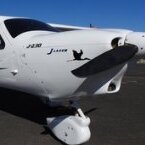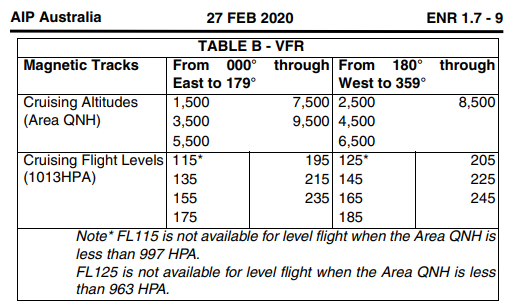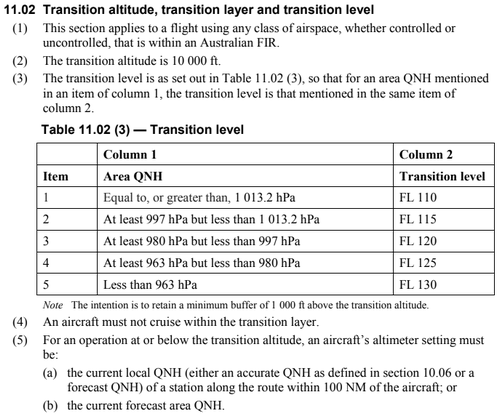-
Posts
3,464 -
Joined
-
Last visited
-
Days Won
47
Content Type
Profiles
Forums
Gallery
Downloads
Blogs
Events
Store
Aircraft
Resources
Tutorials
Articles
Classifieds
Movies
Books
Community Map
Quizzes
Videos Directory
Everything posted by RFguy
-
but certified to what exactly ? the answer to this is in the RAAus tech Manual https://www.raa.asn.au/storage/raaus-technical-manual-issue-41.pdf There is "those that are accepted to be registered"- being a 24- aircraft does not mean is certified to some standard - IE this is not necessarily 'certified'. IE there is nothing special about being certified without qualification - EXCEPT that the aircraft (production) did in some way, have to satisfy CASA Part 21 requirements whether it was stated to meet a industry design regulation for that TYPE, or whether CASA was satisified by means of paperwork from someone that had cred, that it would meet those industry requirements or otherwise required design practice and performance (Thruster I guess) (which is worth something) Now, I hear everyone saying Oh it complies with ASTM for LSA. but there are a tone of standards in this league. look this one up. its a good brief. Search results for: 'Light+sport+aircraft' WWW.ASTM.ORG Four pages of results, and most of it relevant. which is all referenced as a recognized industry standard in : and Part 8 of Part 21, Manual of standards. Part 21 Manual of Standards Instrument 2016 WWW.LEGISLATION.GOV.AU the trail : through the RAAus technical manual : Page 11 is a good start. "Abbreviations and Definitions", and SECTION 3.2 FACTORY BUILT TYPE CERTIFIED or TYPE ACCEPTED AIRCRAFT and SECTION 3.3 LIGHT SPORT AIRCRAFT (LSA) are relevant. While a Thurster is not strictly an LSA< since it predates LSA< I beleive it falls into the same qualified manufacturer backet for this discussion. In spirit, you just need to convince CASA (and how to do that is spelt out ) that it meets a category. In general : CAO 95.55 "Interpretation", Section 5: spells out RAAaus aircraft..... WHich leads us into https://www.casa.gov.au/search-centre/rules/part-21-casr-certification-and-airworthiness-requirements-aircraft-and-parts which two things are spelt out : 21.031 Type design—meaning and 21.041 Type certificate—meaning 21.172 Definitions for Subpart : 21.172 Definitions for Subpart In this Subpart: LSA standards means: (a) the standards for the design, performance or continuing airworthiness of light sport aircraft issued by the American Society for Testing and Materials, as in force from time to time; or (b) the standards prescribed by the Part 21 Manual of Standards for the design, performance or continuing airworthiness of light sport aircraft. Note: The standards issued by the American Society for Testing and Materials could in 2015 be viewed on the society’s website (http://www.astm.com). qualified manufacturer of a light sport aircraft means: (a) a manufacturer who, at the time the light sport aircraft was manufactured, held a current production certificate for an aircraft; or (b) a manufacturer who has made a written declaration that, at the time the light sport aircraft was manufactured, it had: (i) contracted engineering personnel with experience in ultralight or light aircraft design to ensure compliance with LSA standards referred to in paragraph 21.186(2)(b); and (ii) facilities and tools suitable for the production of the aircraft in accordance with the applicable LSA standards; and (iii) competent personnel, with appropriate training, skills and experience, to perform work that affects product quality. 2.3 For registration, RAAus must be satisfied that the aircraft complies with the standards and conditions of acceptance under the LSA criteria as described in AC 21.41(n) and AC 21.42(n). (where (n) = latest edition) g
-
Conditon report is just that. if there is a fist size hole in the wing, that is written down, has nothing to do with Airworthiness. If the engine has reached TBO, you must do what the mfr says. (that's what I do not like about RAAus - mfr has last word which is not always a competent or true decision) (and why I have essentially left RAA 24-) If the engine has reached calendar, the manufacturer can say you must rebuild it, and you must. Some MFRs have varying rules on this- IE if used for training or hire etc - these are RAAaus organisation tweaks around the edges. on a case by case basis there is facility for RAAus to grant variations and exceptions. As for this term "Certified aircraft" I didnt think there was any such construct in RAAus. Nothign in RAA-aus is 'certified' like a GA aircraft . well it might be but certified to something but to what ? there are many typres of certifications..... The term is used very loosely, obviously.
-

flying in Class E / transition layer question
RFguy replied to RFguy's topic in Aircraft General Discussion
Change is OK. The section of the AIP on this (1.7) from 2017 was a bit of a dogs breakfast. the usual translation from legislation to plain language. The CASA legislation is full of "statement followed by a plethorea of exceptions to that statement " ! that's sort of how the previous AIP section was written. This is better . multiple passes of it and I can be fairly competent of interpreting it as the upper boundary layer (spelt out by the Area QNH) is NOT part of the transition buffer layer. IE if the buffer is FL100 to FL115, (Area QNH >=997 and < 1013 then you can cruise at FL115. -

flying in Class E / transition layer question
RFguy replied to RFguy's topic in Aircraft General Discussion
seems there has been continuous change of this chapter in the AIPs in 2017 there was a section descibed as "Limitation" .. - and it implied NO to my question - IE that you cannot cruise at FL110 if the upper boundary was FL110 for the day. BUT !!! but not in the 2022/- This has been replaced with TABLE 5 - B Table 5 indicates that FL115 is available unless QNH < 997 So this is different - ish -

flying in Class E / transition layer question
RFguy replied to RFguy's topic in Aircraft General Discussion
I have emailed CASA . We'll see what I get back. Generally, a 2D defined medium has boundaries to define it and these are not necessarily inclusive. -

flying in Class E / transition layer question
RFguy replied to RFguy's topic in Aircraft General Discussion
But if you are flying at the 10k' TA, you have altimeter QNH = 1013. (temp effects aside) If an aircraft was flying with altimeter set for 1013 and QNH = 1013 , at an indicated 9500' for they are flying at 9500 PA. If the aircraft was flying with altimeter set for 1013 and QNH actual = 997, (IE reads higher than you really are because air pressure is lower) at an indicated 9500' they are flying at ~ 9500-440'. = ~9060' PA If the aircraft was flying with altimeter set for 1013 and QNH actual = 1030, (IE reads lower than you really are) at an indicated 9500' they are flying at ~ 9500+467'. = ~ 9967' PA umm is that right ? -
I was reading this . So if the upper level of the transition layer is FL115 on the day , can I fly at FL115? Because, by the definition I am not flying inside the transition layer at FL115 . (FL100 to FL115 in this example) about as good as it gets with the Archer is about a DA of 11500.
-
Skippy, do you REALLY need this? IE the SIMULTANEOUS probability of flattening the battery AND not having any vehicles nearby to jump start ? You'd be MUCH better off putting an Anderson SB50 connector somewhere pluggable connected to the battery and make a jumper lead that is that connector to a set of jumper lead crocodle clips. For say a 5 meter length, you will need a copper size of 17mm2. easy ! weight of total 10 meters of cable (5m run) will be 1.523kg. you can buy some 4 B&S 20mm2 high strand count battery cable around the place.
-

Rotax 912uls ignition pinout
RFguy replied to danny_galaga's topic in Instruments, Radios and Electronics
Mark Kyle will know when he pops up -
When we flew with one in Thruster's RV, I made sure I could reach it and drop it over the side . Stuart we probably need a proceedure for this, to ensure it doesnt end up colliding with the empanage components. Any suggestions ? ANy suggested failsafe manouvers for this sort of thing ? I really wonder what manourver for a low wing would be best in this case.
-
I was just looking at the map display with the GPS output . The GPS output labels overwrote the presented data with my text sizing at maximum.
-
The Skyecho is not a high accuracy device. That's the problem. I am surprised that SkyEchoes are even permitted given they can transmit bogus positions. WHAT THAT DISCUSSION you point to is about- Is the question of whether a TSO Transponder can be substituted by a Skyecho - and the answer is NO. The TSO transponder is still the gold standard, and required for working with industry facilities like TCAS etc. SKyecho, being a non ship power item, with a variable fix performance is not an acceptable substitute.
-
SO Reading through the rules again, there isnt any requirement for TSO grade ADS-B OUT in Class E airspace. So SkyEcho is fine as a 'tail light' . There is , as I interpret it, a requirement for at least Class C transponder (transmits altitude). Class E is buzzing with IFR flights. You are expected to maintain your altitude like a tiger. (and observe Axxx / FL region changes of course) , keep an eagle ear on the radio, and steer clear of IFR routes and it is polite to advise center of your intentions if no flight plan or otherwise. (AIP 3.2) Be sure to understand how the transition layer varies with area QNH (CASR Part91 MOS 11.02) -glen
-
OK, OZ RUNWAYS have fixed the bugs I complained about (so far) in the past New is 5.3.7 apparently.. 5.3.6 is on the play store, so a fix is in the pipeline. Well , that was pretty good. I have forwarded another few bugs to them....
-
ahh there's no transistors in a Jab system- they are impulse... just that you dont get much impulse at slow RPM (voltage somewhat proportional to rotation) . (assumes no cold start kit). Not sure what is in the cold start kit.
-
the "super capacitor " battery backups are actually a lithium cell and a large super cap in paralle- the ones I have seen. mostly marketing fluff. BS To start the rotax takes about, for a 5 second crank, about 6kJ capacitors are not all that useful because the energy stored is proportional to the voltage, this means that you can only use the top 50% or so and thus makes a poor utilization Example- 100 Farad (huge) super cap charged up to 14.4 V = 10.3kJ. 100 Farad cap at 10V (lowest useful starter cable source voltage ) 5kJ So, difference of 5.3kJ is available. Here are some super capacitors- you'd to 6 in series to be safe to use for a 12V system. BUT the law of capacitors in series is C total = 1 / (1/C1 + 1/C2 + 1/Cn) https://www.mouser.com/ProductDetail/Maxwell-Technologies/BCAP0100-P300-S17?qs=W%2FMpXkg%2BdQ6IrVZMho%2FgPw%3D%3D If its full of low grade super caps, it iwll be useless due to internal resistance. So the capacitance of 6 in series is only 1/6 of a single only 16.6 F. so you now need 6 in series, and 6 banks of those in parallel. and this puts the screws on the permissable internal series resistance- you you got to use expensive ones ! Or 36 capacitors.... The stored energy is quite dangerous. If there was any fault condition - at all, this could easy generate an instant fire and set fire to anything Why is it so dangerous ? because the energy can be released essentially instantaneously. total energy stored would be 36 x 10kJ = 360kJ. and with a very low series impedance . peak current is likely to be > 2800 amps (calculated) this could set fire to a PVC insulated copper starter cable, or explode a solenoid etc . you take it.... 360kJ is the same as ~ 100 grams of TNT so, a good old healthy battery is fine.
-
Well, I tried AVPLAN on android. lots of DIFFERENT problems. not bugs or not-working features (like RWYS Android buggy) - --, very much confusing and irritating user interface problems. Like text sizes resizing when you dont want them to, screen things being masked in portrait/landscape mode but it doesnt tell you. Non responsive GUI when some function not applicable to the mode, generally less intuitive user interface than RWYS. Seems to be stronger on flight planning, and MUCH LESS fluff than RWYS. I was unimpressed- I uninstalled it.
-
it's piss poor. the flight plan lodgement stuff is flakey. it's terrible. will try Avplan.
-
has anyone been able to LODGE a flight plan with the Android version ? I get some weird hex code and ' unknown error' FFS.
-
mmmmmm. avplan. yeah if the documentation for RWYS Android app was separate and up to date, it wouldnt be as much of a cluster-firetruck.... Simple stuff is wrong or doesnt work, like editing the altitude in a flight plan, and you must click "Discard changes" to have the altitude numbers take hold- that sort of problem, from my point of view as a professional software developer means I should doubt ANYTHING that OZ runways presents to me that has that sort of bug. IE I can't trust the information being presented if those sorts of problems are in there. That and numerous error messages and faults when trying things described in the documentation - faulting because they're not supported is unacceptable.
-
SO I've loaded Ozrunways onto a Samsung A8 64GB wifi tablet. good tablet. But the Ozrunways Android seems very much half baked. bugs everywhere. unsupported features documentation unsuitable same price. this is a bit piss poor. Is a Ipad the only descent option ? glen.
-
Yes. direct. shotgun line .... I reckon the region between Capertee and Putty is the worst, as between Putty and Cessnock, there is SOME clearing. Given that Maitland could be fogged in , and Cessnock also fogged, need to carefully consider the TAF for the region before travelling. yesterday well it was beautiful. IE IF the TAF says PROB 30 for fog, that's a bit of a red flag. Need to get my NVFR rating , since fog in the morning (like yesterday) delays starts and the day runs late and behind schedule.. But yesterday I was concerned about a fog moving in early in the evening at Cowra , on the way back, I could see fogs forming in regions around 30 minutes out of CWR in the distance.....and I realised that arriving at sunset without an alternate option (no NVFR) wasn't the best planning. Had 2h fuel remaining on landing . Yeah I can land and nav the dark but I am not permitted to, and GA is not like driving on the road where you can flout rules. I got on the radio and found humidity was low at YCWR , and so that was OK- no fog.... Cowra never has evening fog, and there are cross RWYs and lights and NDB so shouldn't need one. But never say never ....
-
yep, that is my understand precisely. if you are going to mix it with IFR then you must have a TSO-C199 (or higher spec like a TSO 146) .
-
Not sure the SE2 cuts the mustard. I have a GTX335 ADSB-OUT to go in. I'll find out. That region / area is filled with IFR traffic. The other thing is, going much higher than 11,000 feet, there might be diminishing returns to just flying around the tiger country. Probably would depend on weather, many things . If the there was ANY cloud, I'd likely fly around the north of the tigers, (25nm ?) since if you want to even further reduce your survival probabilities, add a cloud near the ground to the mix. And at the Maitland etc, itd be a quick decent..... there is CTA just east of Cessnock en route (4500 step), and to get into Maitland, I was at 4500 as I was overhead Cessnock, and 4000 at the step. and I'd likely need to use a VFR approach point in to WIlliamtown CTA. dunno have to check that.
-
skippy said : "200% agree!!! Air flow/cooling is , for those without a wind tunnel and all sorts of sensors, a dark art." Skippy how can you 200% agree on something ? Surely this means you never properly measured your agreement correctly in the past if this is a 200% agreement ?









